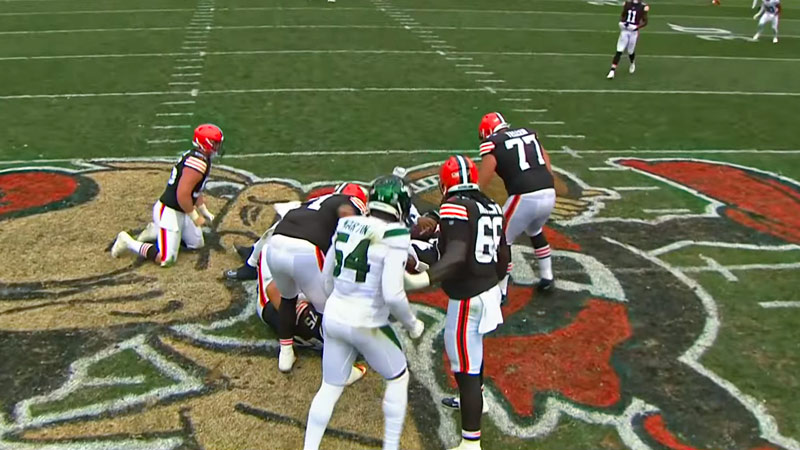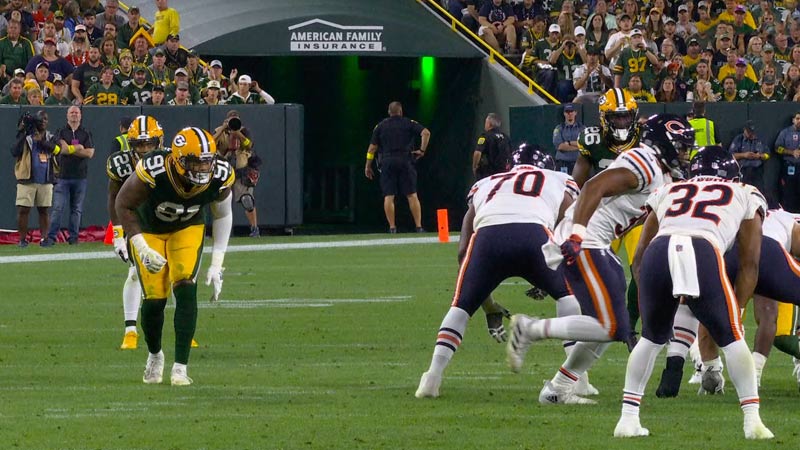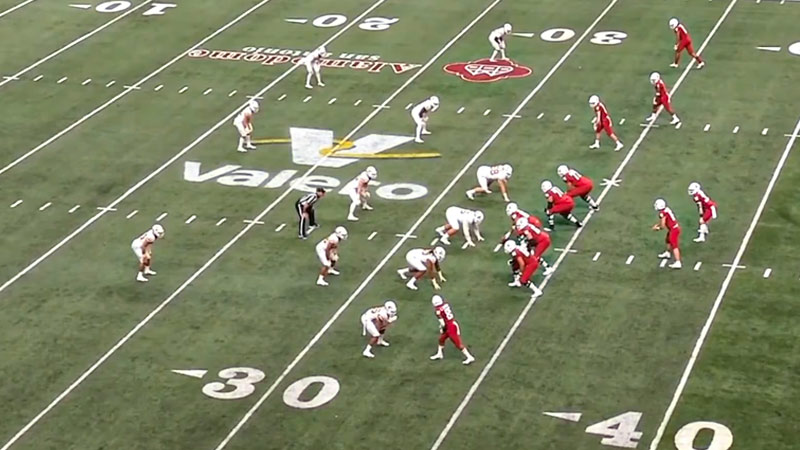In the dynamic world of American football, strategies continuously evolve to outsmart opponents and secure victory. One such strategy that has stood the test of time is the implementation of vertical routes.
These high-flying passing plays are designed to stretch the defense vertically, creating opportunities for explosive gains and game-changing touchdowns.
In this blog post, we delve into the intricacies of football vertical routes, breaking down their significance, execution, and the impact they have on the game.
Whether you’re a die-hard football fan or simply curious about the tactical intricacies of the sport, read on to gain valuable insights into how vertical routes elevate the art of passing in football. So, stay focused.
What Is Football Vertical Routes?
Football vertical routes are a type of passing play in American football where wide receivers sprint directly up the field, aiming to stretch the defense vertically.
These routes are designed to exploit the deep areas of the field, forcing defenders to cover a large distance quickly and creating opportunities for big gains.
Common vertical routes include the “Go” route, where the receiver runs straight downfield; the “Post” route, involving an angled cut towards the middle of the field after a certain distance; and the “Corner” route, where the receiver initially heads upfield before sharply cutting towards the sideline.
Quarterbacks aim to connect with receivers on these routes, relying on precise timing and strong arm strength to deliver the ball deep downfield, challenging the defense and potentially leading to explosive offensive plays.
How to Utilize Vertical Routes in Football?
Utilizing vertical routes effectively in football requires a combination of strategic planning, execution, and player skills. Here’s how to make the most of vertical routes:
Play Calling and Formation
- Incorporate vertical routes into your offensive playbook, selecting plays that suit your quarterback’s arm strength and the receiver’s speed.
- Choose formations that spread out the defense, creating space for the vertical routes to exploit.
Personnel Selection
- Assign your fastest and most agile wide receivers to run vertical routes, as they need to beat defenders deep.
- Consider using a mix of different receiver types to keep the defense guessing and prevent them from solely focusing on deep routes.
Timing and Execution
- Timing is crucial; the quarterback needs to release the ball as the receiver reaches a specific point in their route.
- Receivers must use proper technique to maintain their speed, avoid being jammed at the line of scrimmage, and create separation from defenders.
Protection
- Adequate pass protection is essential for allowing the quarterback to comfortably wait for the vertical routes to develop.
- The offensive line should give the quarterback enough time to read the defense and make accurate throws downfield.
Route Combinations
- Combine vertical routes with other route concepts to create confusion among defenders and exploit openings in their coverage.
- Crossing routes and underneath routes can draw defenders away from the deep areas, leaving room for vertical routes.
Pre-Snap Reads
- Quarterbacks should read the defense before the snap to identify potential mismatches or open areas for the vertical routes.
- Adjust the play call based on the defensive alignment to maximize the chances of success.
Adjustments
- Be prepared to adjust your strategy if the defense starts defending against vertical routes effectively.
- Use play-action passes to freeze linebackers and safeties, opening up opportunities for receivers running deep.
Practice and Repetition
- Both quarterbacks and receivers should practice their timing and connection on vertical routes extensively during practice.
- Repetition helps build trust between the quarterback and receivers, increasing the likelihood of successful deep throws.
Situational Awareness
Understand the game situation and when to utilize vertical routes; they can be particularly effective in crucial moments or when you need to gain significant yardage quickly.
Adjusting to Defense
If the defense consistently defends against vertical routes, adapt by incorporating shorter passes, screens, or intermediate routes to keep them off balance.
Vertical routes can be game-changers, but their success relies on a well-coordinated effort between the quarterback, receivers, and the offensive line.
Strategies to Utilize a Vertical Stretch

Utilizing a vertical stretch effectively in football involves creating opportunities for deep passes that force the defense to cover the entire length of the field. Here are strategies to make the most of a vertical stretch:
Spread Formation
Use formations that spread out the defense, increasing the width of the field and creating more one-on-one matchups for your receivers.
Speedy Receivers
- Assign your fastest and most agile receivers to run vertical routes.
- Speedy receivers can stretch the defense and create separation, making them prime targets for deep passes.
Pre-Snap Reads
Quarterbacks should read the defense’s alignment before the snap to identify potential mismatches or vulnerabilities in the secondary coverage.
Play-Action Passes
- Employ play-action passes to freeze linebackers and safeties, creating a brief window of opportunity for the deep throw.
- Play-action can draw defenders toward the line of scrimmage, leaving the secondary vulnerable to deep passes.
Route Combinations
- Combine vertical routes with crossing routes or underneath routes to create confusion in the defense.
- Crossing routes can clear out defenders and create space for the deep receiver to exploit.
Double Moves
- Teach receivers to use double moves, where they initially appear to run a short or intermediate route before suddenly accelerating deep.
- Double moves can catch defensive backs off guard and lead to big gains.
Exploiting Matchups
- Identify favorable matchups between your receivers and the opposing defensive backs.
- Target weaker defenders or exploit height and size advantages to win jump-ball situations.
Protection
- Provide strong pass protection to allow the quarterback enough time to survey the field and launch deep passes.
- Adequate protection is crucial for deep routes to fully develop.
Quick Release
Teach quarterbacks to have a quick release on deep passes, reducing the time defenders have to react and adjust to the throw.
Situational Awareness
- Recognize when to take shots downfield, such as in critical moments, when trailing, or when the defense is expecting a run.
- Adjust your strategy based on the score, time remaining, and field position.
Adjustments
- Be prepared to adjust your approach if the defense adjusts to your vertical stretch strategy.
- If they play deep coverage, take advantage of shorter routes or screens to keep them off balance.
Practice and Chemistry
- Develop the chemistry between the quarterback and receivers through practice repetitions.
- Deep throws require precise timing and trust between the players.
How to Stop A Veer Offense in Football?

Stopping a veer offense in football, which relies on misdirection, option plays, and quick decision-making by the quarterback and running backs requires a solid defensive strategy and disciplined execution. Here are some key steps to effectively defend against a veer offense:
Assignment Football
- Assign defenders specific responsibilities to cover each potential ball carrier in the option play, including the quarterback, running back, and pitchman.
- Maintain gap discipline to prevent gaps from opening up in the defensive line, which the offense can exploit.
Defensive Line Technique
- Defensive linemen should play a “squeeze and scrape” technique, where they squeeze down the line of scrimmage to force the ball carrier to commit, and then scrape along the line to pursue the play.
- Defensive linemen need to read the mesh point (the point where the quarterback and running back make their decision) and react accordingly.
Linebacker Play
- Linebackers play a crucial role in defending the veer offense by reading the quarterback’s decision.
- Inside linebackers are responsible for the dive back, while outside linebackers are responsible for the pitchman.
- Maintain outside leverage to prevent the pitch option and force the play back inside.
Containment and Edge Defense
- Maintain strong contain on the edges of the defense to prevent the quarterback from getting outside and gaining yardage.
- Outside defenders (cornerbacks and safeties) should set the edge and force the play back toward the pursuing defenders.
Backside Pursuit
- Backside defenders must maintain discipline and pursue the play even if it appears to be flowing away from them.
- The cutback lane can be a vulnerability if defenders overcommit to the play’s initial direction.
Secondary Support
Safeties and cornerbacks should be ready to support against the pitch option and provide additional pursuit on the ball carrier.
Tackling Fundamentals
- Solid tackling is essential, as the veer offense aims to create one-on-one situations in open space.
- Wrap up ball carriers securely to prevent extra yardage and potential big plays.
Disruption and Penetration
Defensive linemen who can penetrate the offensive line disrupt the timing of the veer offense and force quick decisions.
Pressure and Blitzing
- Well-timed blitzes can disrupt the veer offense’s rhythm and force hurried decisions by the quarterback.
- However, be cautious with blitzing, as it can leave gaps open for the offense to exploit.
Film Study and Preparation
- Study the opponent’s veer offense tendencies, formations, and play-calling patterns to anticipate their strategies.
- Develop a game plan based on your team’s defensive strengths and the opponent’s weaknesses.
Communication
Maintain clear communication among defenders to ensure everyone understands their assignments and responsibilities.
Adaptation and Adjustments
- Be prepared to make in-game adjustments based on how the offense is attacking your defense.
- If something isn’t working, make necessary tweaks to counter the veer offense’s tactics.
Stopping a veer offense requires a cohesive defensive effort, disciplined play, and a thorough understanding of the offense’s principles.
Importance of Vertical Routes on Football
Vertical routes play a crucial role in football due to their ability to stretch and challenge the defense deep downfield. They offer several important advantages that can significantly impact the outcome of a game:
Explosive Plays
Vertical routes create opportunities for explosive, game-changing plays. A well-executed deep pass can quickly cover a large portion of the field, leading to substantial gains and potential touchdowns.
Defensive Stress
Defenses must allocate resources to cover vertical routes, potentially leaving other areas of the field less defended. This can create mismatches and open up opportunities for other offensive plays.
Defensive Alignment
Opposing defenses are forced to play further back to prevent deep completions, which can create more space for intermediate routes, underneath passes, and running plays. This can help diversify your offensive attack.
Field Position Advantage
Successful vertical routes can rapidly shift the field position in favor of the offense, placing them closer to the opponent’s end zone and increasing the chances of scoring.
Confidence Boost
Successfully connecting on a deep pass can energize the entire offense, boosting morale and making the team more confident in its ability to move the ball effectively.
Drawing Penalties
Defenders, fearing the potential big play, might resort to holding or interfering with receivers running vertical routes, leading to defensive penalties and additional yardage for the offense.
Opening Up the Run Game
A strong vertical passing threat can force safeties and linebackers to drop into coverage, lightening the box near the line of scrimmage. This can create better opportunities for running backs to find holes and gain yardage.
Decoy Effect
Even if the deep pass isn’t always completed, the threat of the vertical route can draw defenders away from other routes and create open windows for intermediate and short passes.
Time of Possession
Successful vertical routes can result in quick touchdowns, minimizing the time the defense spends on the field and helping to control the game’s tempo.
Psychological Impact
The defense must constantly be aware of the potential for deep passes, which can make defenders hesitant or cautious in their coverage assignments.
FAQs
What Are Vertical Routes in Football?
Vertical routes in football are passing plays where wide receivers sprint straight up the field to stretch the defense vertically. These routes aim to exploit the deep areas of the field, creating opportunities for quarterbacks to deliver long passes and receivers to gain significant yardage.
How Do Vertical Routes Impact Defenses?
Vertical routes force defenses to adjust their coverage and allocate resources to prevent deep completions. This opens up opportunities for other offensive plays, creates mismatches, and alters the defense’s alignment to the offense’s advantage.
What Are Common Types of Vertical Routes?
Common vertical routes include the “Go” route, where the receiver runs straight downfield; the “Post” route, involving an angled cut towards the middle of the field; and the “Corner” route, where the receiver heads upfield before sharply cutting towards the sideline.
How Do Quarterbacks Execute Vertical Routes?
Quarterbacks must have strong arm strength and timing to execute vertical routes effectively. They read the defense pre-snap, assess matchups, and release the ball at the right moment to allow receivers to run under it, maximizing the chance of a completion.
What Factors Contribute to Successful Vertical Routes?
Successful vertical routes hinge on several factors, including the speed and agility of receivers, offensive line protection, accurate quarterback throws, route combinations, and the element of surprise in play calling.
Wrapping Up
Football vertical routes epitomize the strategic depth of the sport, showcasing the delicate balance between precise execution and intelligent play calling.
By stretching the field, challenging defenses, and creating opportunities for explosive plays, vertical routes have become an integral part of modern football offenses.
Their mechanics sheds light on the intricate dance between quarterbacks, receivers, and defenders, and provides fans with a newfound appreciation for the artistry of passing in the game.
As football continues to evolve, vertical routes remain a timeless tactic that can turn the tide of any match, making every deep pass a potential game-changer. Best of luck.







